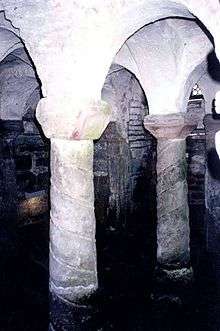Repton
Coordinates: 52°50′17″N 1°32′56″W / 52.838°N 1.549°W
Repton is a village and civil parish in the South Derbyshire district of Derbyshire, England, located on the edge of the River Trent floodplain, about 4.5 miles (7 km) north of Swadlincote. The population taken at the 2001 Census was 2,707, increasing to 2,867 at the 2011 Census.[2] Repton is close to the county boundary with neighbouring Staffordshire and about 4.5 miles (7 km) northeast of Burton upon Trent.
The village is noted for St Wystan's Church, Repton School and the Anglo-Saxon Repton Abbey and medieval Repton Priory.
History
Christianity was reintroduced to the Midlands at Repton, where some of the Mercian royal family under Peada were baptised in AD 653. Soon a double abbey under an Abbess was built.
In 669 the Bishop of Mercia translated his see from Repton to Lichfield. Offa, King of Mercia, seemed to resent his own bishops paying allegiance to the Archbishop of Canterbury in Kent who, while under Offa's control, was not of his own kingdom of Mercia. Offa therefore created his own Archdiocese of Lichfield, which presided over all the bishops from the Humber to the Thames. Repton was thus the forebear of the archdiocese of Lichfield, a third archdiocese of the English church: Lichfield, the other two being Canterbury and York. This lasted for only 16 years, however, before Mercia returned to being under the Archbishopric of Canterbury.

At the centre of the village is the Church of England parish church of Saint Wystan: St. Wystan's Church, Repton. The church is notable for its Anglo-Saxon crypt, which was built in the 8th century AD[3] as a mausoleum for the Mercian royal family. Wystan, or Wigstan, was a prince of Mercia who was murdered by his guardian in 849,[4] in the reign of Wiglaf. His remains were buried in the crypt at Repton and miracles were ascribed to them. Repton proceeded to become a place of pilgrimage; Wigstan was later canonised and became the patron saint of the church.
In 873/4 the Danish Great Heathen Army overwintered at Repton, the only place in England where a winter encampment has been located, identified by a mass grave of some 250 individuals, covered by the kerb stone of its former cairn. The bones were disarticulated, long bones stacked together with skulls on top. Forensic study revealed that the individuals ranged in age from their late teens to about forty, four men to every woman. Five associated pennies fit well with the overwintering date of 873/4. The absence of injury marks suggest that the party had perhaps died from some kind of contagious disease.[5]
Parish church
At the north edge of the village is St Wystan's Church, an Anglo-Saxon church dedicated to the Anglo-Saxon Saint Wystan (or Wigstan) and designated by English Heritage as a Grade I listed building.[6] The 8th-century crypt beside the church is the burial place to Saint Wigstan, as well as his grandfather, King Wiglaf of Mercia. Also buried there is King Æthelbald of Mercia, under whose reign the building was first constructed, and for whom it was first converted to a mausoleum. Upon the burial of St Wigstan, the crypt became a shrine and place of pilgrimage.[7]
The cruciform Anglo-Saxon church itself has had several additions and restorations throughout its history, including Medieval Gothic north and south aisles in the nave that were rebuilt in the 13th century and widened early in the 14th century, and the addition in 1340 of the west tower and recessed spire.[8] The church was also restored between 1885 and 1886 by Arthur Blomfield.[9]
Notable residents
- King Æthelbald of Mercia was buried here in 757 AD.[10]
- Beornrad of Mercia was buried here[11]
- Saint Guthlac of Croyland was a monk here in about AD 697.
- Russell Osman, international footballer, was born here in 1959.[12]
- King Wiglaf of Mercia was buried here
- Basil Rathbone lived in his childhood here
- Saint Wigstan of Mercia was buried here, although his remains were later removed to Evesham Abbey[13]
- Industrialist Walter Somers was born in Repton in 1839.
- Elsie Steele (1899–2010), the oldest documented person in Britain at the time of her death, lived at The Dales Residential Home in Fisher Close during the final few years of her life.[14]
Gallery
- Thatching in progress, May 2007
- The Mount Pleasant
- The Bull's Head
 The crypt at St Wystan's Church
The crypt at St Wystan's Church
See also
References
- ↑ "Area selected: South Derbyshire (Non-Metropolitan District)". Neighbourhood Statistics: Full Dataset View. Office for National Statistics. Retrieved 29 September 2011.
- ↑ "Civil parish population 2011". Neighbourhood Statistics. Office for National Statistics. Retrieved 30 March 2016.
- ↑ Pevsner & Williamson, 1978, pages 304–305
- ↑ Pevsner & Williamson, 1978, page 303
- ↑ Hall, Richard (2010). Viking Age Archaeology. Shire archaeology. Princes Risborough: Shire Publications. pp. 14ff. ISBN 0-7478-0063-4.
- ↑ Historic England. "Church of St Wystan, Repton (1334560)". National Heritage List for England. Retrieved 16 August 2012.
- ↑ "The Crypt". St Wystan's Church, Repton. Retrieved 22 March 2013.
- ↑ Pevsner & Williamson, 1978, page 305
- ↑ Derby Mercury – Wednesday 28 July 1886
- ↑ Kirby, D.P. (1992). The Earliest English Kings. Routledge. p. 134. ISBN 0-415-09086-5.
- ↑ Swanton, 1996, pages 755, 757
- ↑ "Russell Osman". EnglandStats.com. Retrieved 8 October 2016.
- ↑ Swanton, 1996, pages 48–49
- ↑ Smyth, Rob (10 September 2010). "Girl who delivered Mail is now UK's oldest person". Burton Mail.
Further reading
- Page, W.H., ed. (1907). "Houses of Austin canons: The priory of Repton, with the cell of Calke". A History of the County of Derby, Volume 2. Victoria County History. pp. 58–63.
- Pevsner, Nikolaus; Williamson, Elizabeth (1978) [1953]. Derbyshire. The Buildings of England. Harmondsworth: Penguin Books. pp. 303–308. ISBN 0-14-071008-6.
- Swanton, Michael (1996). The Anglo-Saxon Chronicle. Routledge. ISBN 0-415-92129-5.
External links
| Wikimedia Commons has media related to Repton. |

